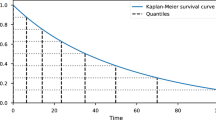Summary
Neural networks can be used as pattern recognition systems in complex data sets. We are exploring their utility in performing survival analysis to predict time to relapse or death. This technique has the potential to find easily some types of very complex interactions in data that would not be easily recognized by conventional statistical methods. In this paper we demonstrate that there are several ways neural networks can be used to find three-way interactions among variables. Thus, in data sets where such complex interactions exist, neural networks may find utility in detecting such interactions and in helping to produce predictive models.
Similar content being viewed by others
References
Anonymous: Consensus statement: Treatment of earlystage breast cancer. National Institutes of Health Consensus Development Panel. J Natl Cancer Institute Monographs 11:1–5, 1992.
Cox DR: Regression models and life-tables. J Roy Stat Soc [B] 34:187–200, 1972.
Tibshirani R: A plain man's guide to the proportional hazards model. Clin Invest Med 5: 63–68, 1982.
Erlichman C, Warde P, Gadalla T, Ciampi A, Baskerville T: RECPAM analysis of prognostic factors in patients with stage III breast cancer. Breast Cancer Res Treat 16:231–242, 1990.
Breiman L, Freidman JH, Olshen RA: Classification and Regression Trees. Wadsworth, Belmont CA, 1984.
Ravdin PM, Clark GM, Hilsenbeck SG, Owens MA, Vendely P, Pandian MR, McGuire WL: A demonstration that breast cancer recurrence can be predicted by neural network analysis. Breast Cancer Res Treat 21:47–53, 1991.
Ravdin PM, Clark GM: A practical application of neural network analysis for predicting outcome of individual breast cancer patients. Breast Cancer Res Treat 22:285–293, 1992.
Baxt WG: Analysis of the clinical variables driving decision in an artificial neural network trained to identify the presence of myocardial infarction. Annals Emerg Med 21:1439–1444, 1992.
Rost B, Sander C: Improved prediction of protein secondary structure by use of sequence profiles and neural networks. Proc Natl Acad Sci 90:7558–7562, 1993.
Zweig MH, Campbell G: ROC plots: A fundamental evaluation tool in clinical medicine. Clin Chem 39:561–577, 1993.
Author information
Authors and Affiliations
Corresponding author
Rights and permissions
About this article
Cite this article
De Laurentiis, M., Ravdin, P.M. Survival analysis of censored data: Neural network analysis detection of complex interactions between variables. Breast Cancer Res Tr 32, 113–118 (1994). https://doi.org/10.1007/BF00666212
Issue Date:
DOI: https://doi.org/10.1007/BF00666212




